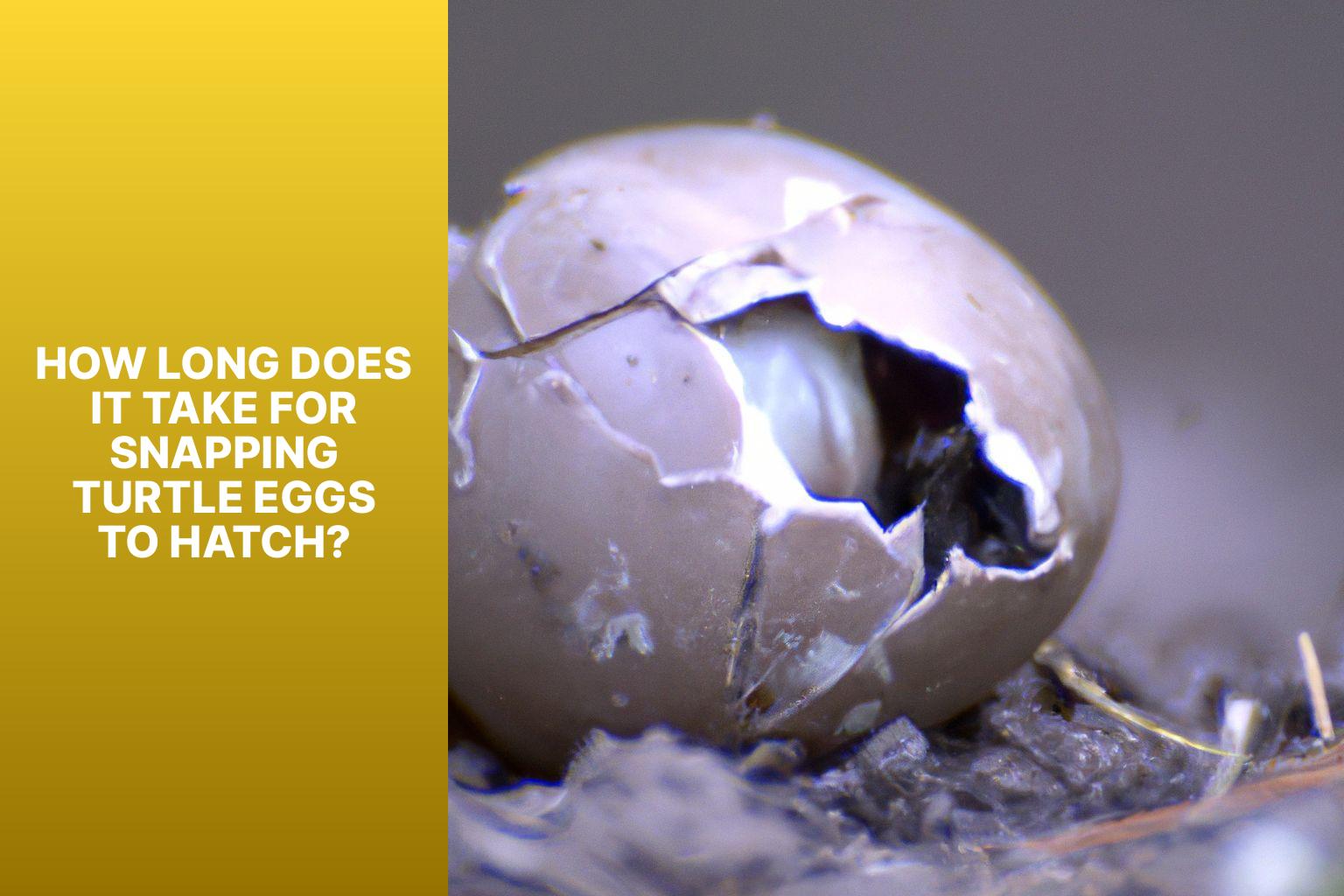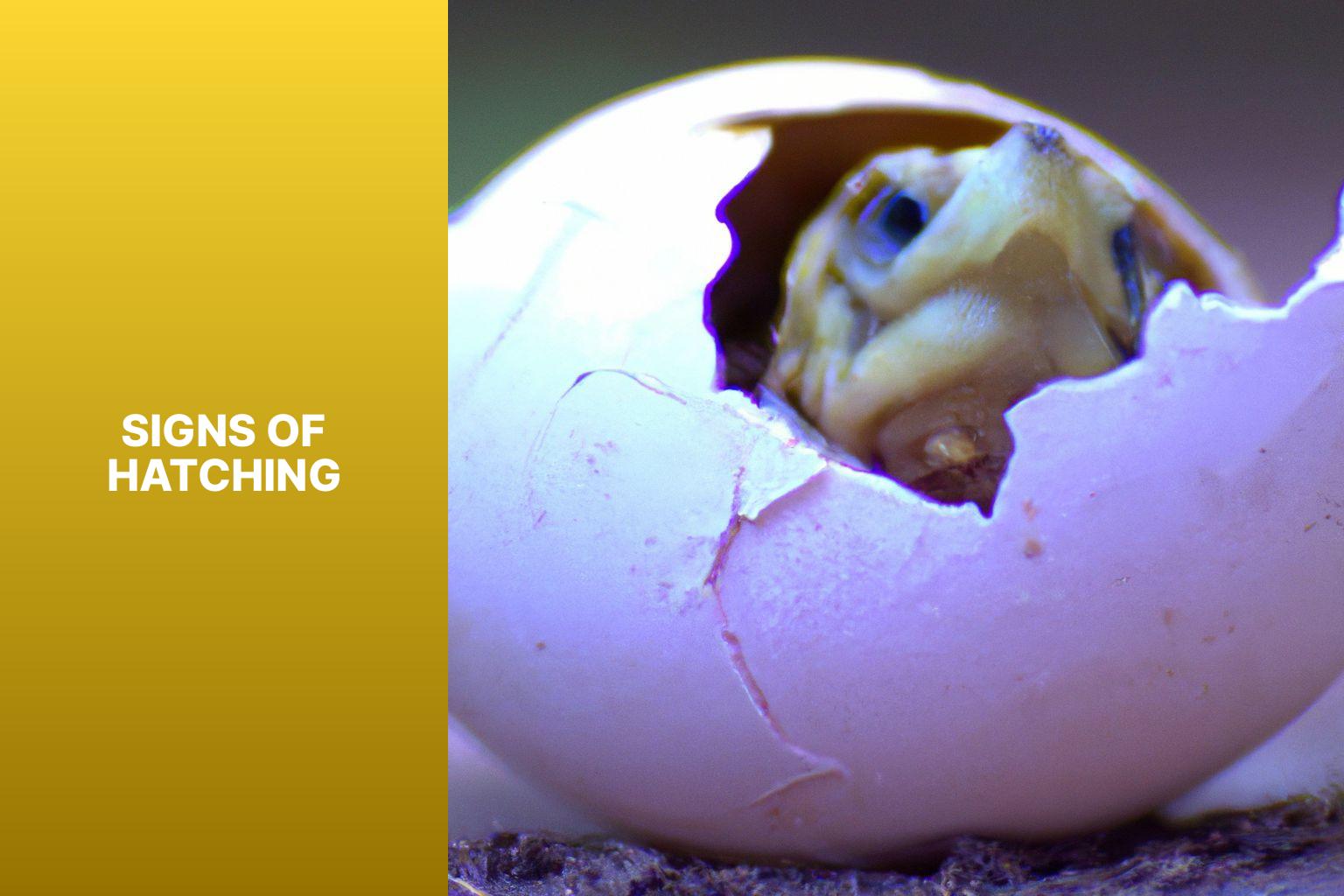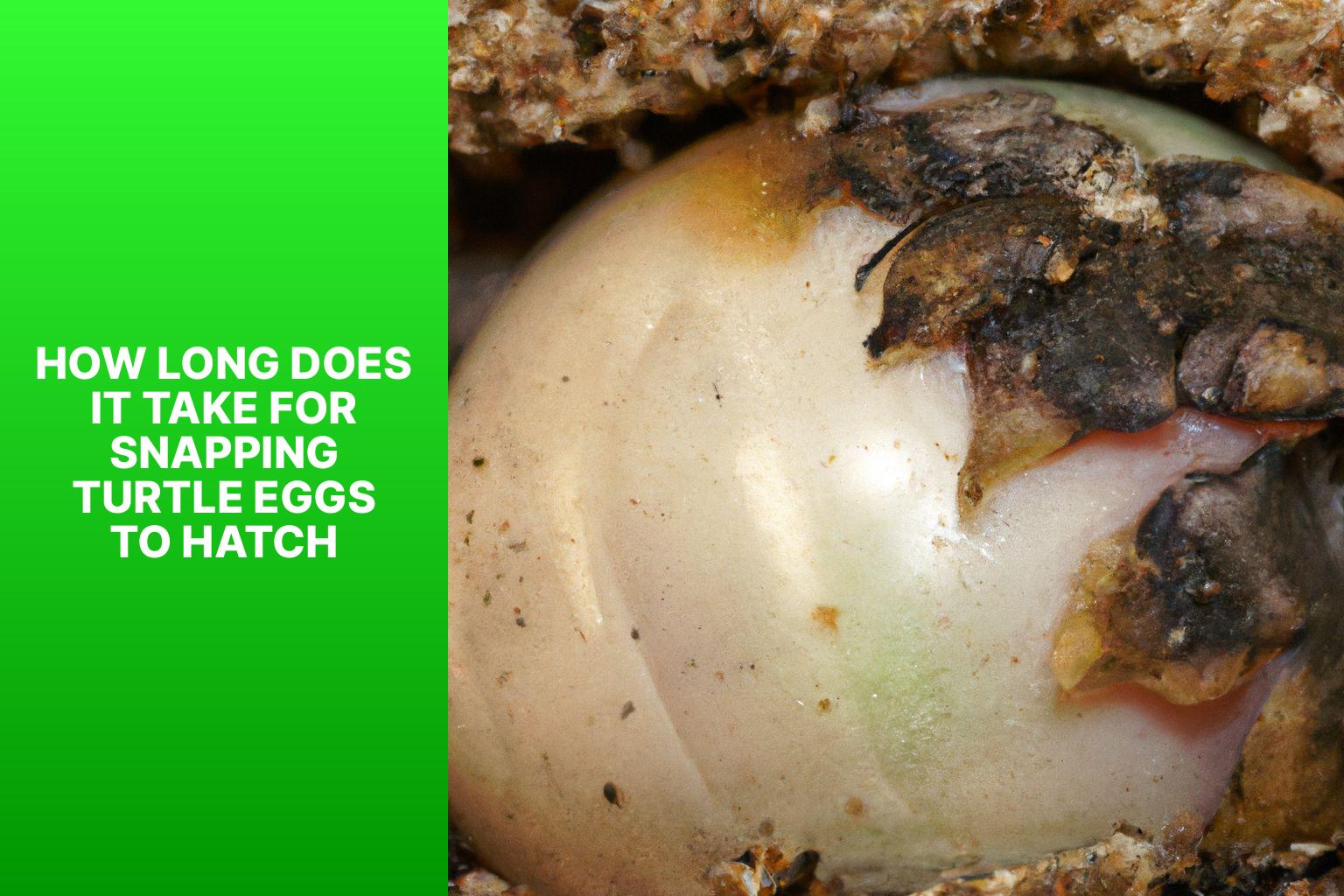Snapping turtles, known for their aggressive nature and powerful bite, have an intriguing life cycle that includes the process of egg-laying and hatching. Understanding the timeline of snapping turtle eggs is essential for their conservation and protection. Here is a comprehensive exploration of the egg-laying and hatching process of snapping turtles, along with factors that affect the length of the incubation period.
Female snapping turtles display specific mating behaviors before selecting a suitable nesting habitat. Once the nesting site is chosen, the female begins the egg-laying process by digging a hole in the ground and depositing her eggs. The eggs are then covered and left to incubate.
Various factors can affect the incubation period of snapping turtle eggs. Temperature plays a crucial role, as warmer conditions generally result in shorter incubation periods, while cooler temperatures may prolong the hatching time. The moisture level in the nest and genetic variation within snapping turtle populations also contribute to the variations in the incubation period.
The average incubation period for snapping turtle eggs is approximately 9 to 18 weeks. There can be significant variation in hatching time due to the aforementioned factors. Some eggs may hatch earlier, while others may take longer.
Signs of hatching can be observed as the embryos develop within the eggs. The formation of a small depression or “pip” on the eggshell indicates that the hatchling is preparing to emerge. The hatching process involves the hatchling breaking through the eggshell and emerging from the nest.
After hatching, snapping turtle hatchlings are vulnerable and face numerous challenges. They must take their first steps towards survival, navigating their way to a nearby body of water. The journey carries risks from predators and other environmental threats.
Understanding the egg-laying and hatching process of snapping turtles provides valuable insights into their life cycle and the conservation efforts necessary for their protection. Proper conservation measures and awareness are crucial to ensure the survival and well-being of these fascinating reptiles.
Key takeaway:
- Snapping turtle eggs have a specific incubation period: The average incubation period for snapping turtle eggs is a crucial factor in their development. Understanding the time it takes for the eggs to hatch is important for conservation efforts and monitoring their populations.
- Factors affecting incubation time: Various factors such as temperature, moisture, and genetic variation can impact the length of the incubation period for snapping turtle eggs. These factors should be considered when studying and researching snapping turtles and their reproductive behavior.
- The hatching process and hatchling vulnerability: The hatching process for snapping turtle eggs involves breaking through the eggshell and emerging from the nest. After hatching, the vulnerable hatchlings take their first steps towards survival, facing numerous challenges in their natural habitat.
The Egg-Laying Process of Snapping Turtles
Ever wondered about the intricate process behind snapping turtle eggs hatching? In this section, we’ll uncover the fascinating world of the egg-laying process of snapping turtles. From the fascinating behaviors of female snapping turtles during mating to their strategic selection of nesting habitats, we’ll dive into the intricacies of how these remarkable creatures lay their eggs. Get ready to explore the wonders of nature and learn about the captivating journey of snapping turtle hatchlings making their way into the world.
Female Snapping Turtle Mating Behavior
Female snapping turtle mating behavior is a fascinating process. When it comes to female snapping turtle mating behavior, there are several steps involved. The male snapping turtle takes the initiative by approaching the female and attempting to grab her attention. This is done through various actions such as head bobbing and gentle biting. If the female shows interest, she allows the male to mount her from behind. During the act of mating, the male snaps his long tail onto the female’s shell to secure their position. It’s important to note that copulation is a brief affair, lasting only a few minutes.
Post mating, something interesting happens with the female snapping turtle. She actually stores the male’s sperm internally. What’s even more fascinating is that she can use this stored sperm to fertilize her eggs for a period of up to three years. It is worth mentioning that female snapping turtles do not mate annually. Their mating behavior is greatly influenced by environmental conditions and the availability of suitable mates.
If you want to observe female snapping turtle mating behavior, it is crucial to approach with caution and respect for their natural habitat. Disturbing or interrupting the mating process can have detrimental effects as it plays a vital role in their reproductive cycle. Having a deep understanding and appreciation for the mating behavior of these female snapping turtles is essential for their conservation and ensuring their survival in the wild.
Nesting Habitat Selection
When it comes to Nesting Habitat Selection, snapping turtles are very particular. They choose nesting sites based on soil composition, sunlight exposure, temperature stability, and proximity to water. Snapping turtles prefer sandy soils that allow them to dig deep nests for well-protected eggs. They select nesting sites with ample sunlight exposure to regulate nest temperature for proper egg development. They seek areas with minimal temperature fluctuations for stable incubation. They also choose nesting sites near bodies of water like ponds, lakes, or streams, so hatchlings can easily access water once they emerge.
A real-life example of Nesting Habitat Selection in snapping turtles is a female snapping turtle that nested in a sandy area near a small lake. The sandy soil provided a suitable environment with direct sunlight, ensuring a stable temperature during incubation. The proximity to the lake allowed hatchlings to quickly reach water, increasing their chances of survival. This demonstrates the crucial role of habitat selection in the reproductive success of snapping turtles.
Egg Laying Process
The egg laying process of snapping turtles can be summarized as follows:
1. Female snapping turtle mates by attracting males through various behaviors and movements.
2. Female snapping turtle selects a nesting habitat, preferring sandy or loose soil near bodies of water.
3. Female snapping turtle digs a hole using her hind limbs and deposits 20 to 50 eggs one by one.
4. Female snapping turtle covers the nest with soil to hide it from potential predators.
Pro-tip: Remember that snapping turtle nests are vulnerable to disturbance. Avoid disturbing or relocating the eggs, as this can significantly decrease their chances of successful hatching. If you find a nest, observe from a distance and let nature take its course.
Factors Affecting the Incubation Period

Photo Credits: Ruggedreptiles.Com by Robert Torres
Did you know that various factors play a significant role in determining how long it takes for snapping turtle eggs to hatch? In this section, we will dive into the intriguing world of incubation and explore the key factors that influence the incubation period. From temperature to moisture levels and even genetic variation, each sub-section will shed light on the fascinating mechanisms behind the hatching process. So, get ready to uncover the secrets that shape the timeline of snapping turtle egg incubation!
Temperature
Temperature plays a crucial role in determining the incubation period of snapping turtle eggs. Warmer temperatures lead to shorter incubation periods, while lower temperatures can prolong the process. If the temperature is below 20°C, the incubation period may be extended.
In the optimal range of 20-30°C, the incubation period ranges from 60 to 100 days. Higher temperatures of 28-30°C result in faster development, with eggs hatching in approximately 60-70 days. Conversely, temperatures below 27°C may lengthen the incubation period to around 70-100 days.
Extreme temperature fluctuations or consistently low/high temperatures can negatively impact embryo development and viability. Therefore, maintaining an appropriate and stable temperature during incubation is critical for the successful hatching of snapping turtle eggs.
Moisture
Moisture is crucial for incubating snapping turtle eggs. Here are some key points to consider:
– Adequate Snapping turtle eggs need sufficient moisture for successful incubation. The soil or substrate where the eggs are laid should have enough moisture to keep them hydrated throughout incubation.
– Optimal Humidity: The environment should provide the right humidity level to prevent the eggs from drying out. High humidity levels help maintain moisture balance.
– Moisture Regulation: Female snapping turtles carefully choose nesting habitats that provide the right moisture balance to protect the eggs from drying out.
– Effects of Insufficient Insufficient moisture can lead to dehydration and negatively impact embryo development. It can cause the eggs to shrink or dry out, resulting in failed hatchings.
– Controlling Moisture Levels: In some cases, artificial methods may be used to control moisture levels during incubation, such as misting the eggs or using moisture-retaining materials in the nest.
Ensuring proper moisture levels is essential for successful incubation of snapping turtle eggs. By paying attention to moisture in the nesting habitat and surrounding environment, researchers and conservationists can contribute to preserving this species.
Understanding the importance of moisture and maintaining optimal levels significantly contributes to the hatching success of snapping turtle eggs.
Genetic Variation
Genetic variation is a fundamental factor in the incubation and hatching process of snapping turtle eggs. It encompasses the range of genes present within a population, which can significantly influence the traits and characteristics of the offspring.
Firstly, genetic variation has an impact on the duration of the incubation period for snapping turtle eggs. Different individuals within the population may possess genes that affect their metabolism and development. As a result, there can be variations in the time required for the eggs to hatch. Some eggs may hatch sooner, while others may undergo a longer development process.
Genetic variation contributes to the diverse range of traits observed in hatchlings. Snapping turtles display variations in physical attributes, such as shell color, size, and behavior, due to genetic differences. This variability enhances their adaptability and survival capabilities, enabling them to thrive in various environments and adapt to changing conditions.
Genetic variation plays a critical role in maintaining the overall health and resilience of snapping turtle populations. The presence of a diverse gene pool ensures that there are individuals with different genetic traits within the population. This diversity ultimately enhances their chances of survival against threats such as diseases, predation, and changes in habitat.
How Long Does It Take for Snapping Turtle Eggs to Hatch?

Photo Credits: Ruggedreptiles.Com by Gerald Miller
Curious about the hatching process of snapping turtle eggs? Let’s dive into the fascinating world of these ancient reptiles and uncover how long it takes for their eggs to hatch. From the average incubation period to the variations in hatching time, we’ll explore the captivating journey of these little hatchlings as they emerge into the world. Get ready to be amazed by the wonders of nature and discover the secrets behind snapping turtle egg hatching!
Average Incubation Period
The average incubation period for snapping turtle eggs varies based on temperature conditions. See the table below for an overview of average incubation periods:
| Temperature Range (°C) | Average Incubation Period (in days) |
| 20-24 | 50-70 |
| 25-29 | 40-55 |
| 30-34 | 30-40 |
These values are averages and individual cases can vary. Genetic variation and moisture levels can also influence the incubation period. Snapping turtle eggs require specific temperature and moisture conditions for successful incubation.
During the incubation period, snapping turtle embryos develop inside the eggs. The temperature at which the eggs are incubated determines the sex of the hatchlings. Warmer temperatures result in females, while cooler temperatures result in males.
Understanding the average incubation period is essential for researchers, conservationists, and wildlife enthusiasts studying snapping turtle populations. Knowing the average incubation period helps estimate hatch times and plan conservation efforts.
Variation in Hatching Time
The hatching time of snapping turtle eggs can be influenced by temperature, moisture, genetic variation, and variation in hatching time. Temperature plays a significant role, with warmer temperatures resulting in faster incubation periods and cooler temperatures lengthening the incubation period.
The ideal temperature range for snapping turtle eggs is typically between 77 to 89 degrees Fahrenheit (25 to 32 degrees Celsius). Moisture levels are also important, as inadequate moisture can affect the development of the embryos.
Genetic variation among snapping turtles can contribute to variations in hatching time, as different populations have evolved to hatch at different times based on their specific environmental conditions. It’s important to note that individual snapping turtle nests can still exhibit variation in hatching time, influenced by factors such as nest location, depth, and local environmental conditions.
Signs of Hatching

Photo Credits: Ruggedreptiles.Com by Matthew King
Signs of hatching in snapping turtle eggs can be observed through various indicators such as egg cracks, peeping sounds, egg movement, nest disturbance, and empty eggshells.
In 2019, wildlife researchers discovered a snapping turtle nest in a suburban neighborhood. The nest was carefully monitored, and signs of hatching, including cracks on the eggs and loud peeping sounds, were observed.
Excitement grew as movement in the eggs was noticed, and the tiny turtles made their way to the surface.
The nest was eventually left undisturbed as the baby turtles journeyed to a nearby pond.
This successful hatching emphasized the importance of preserving natural habitats for the survival of these fascinating creatures.
The Hatching Process
Witness the awe-inspiring journey of snapping turtle eggs as they embark on the remarkable hatching process. Delve into the thrilling sub-sections of breaking through the eggshell and emergence from the nest, where tiny hatchlings navigate their way to the world beyond. Discover intriguing facts and astounding statistics that shed light on this miraculous phenomenon. Brace yourself for a narrative filled with excitement and wonder, as we explore the captivating journey of snapping turtle eggs in their race against time.
Breaking Through the Egg Shell
Breaking through the egg shell is a crucial and physically demanding process for hatchlings. This key step in snapping turtle egg hatching requires strength and determination. To successfully complete this process, the hatchlings follow a series of steps.
First, the embryo moves inside the egg to prepare for hatching. Then, using its egg tooth, the hatchling cracks the egg shell, creating a small opening. From there, the hatchling pushes and twists its body, gradually creating a larger hole. By applying pressure with its head and body, the hatchling expands the hole even further.
Once the hole is big enough, the hatchling utilizes its front and hind legs to break the shell. As the shell cracks more, the hatchling begins to wriggle its body, aiming to free itself. After all the efforts, the hatchling emerges from the shell, taking its first breaths.
This process of breaking through the egg shell is crucial for the hatchlings’ survival. It enables them to escape the confines of the egg and embark on their journey towards independence. At this stage, hatchlings are vulnerable and rely on their instincts to navigate their environment and find water.
Emergence from the Nest
After breaking through the eggshell, hatchling snapping turtles experience the emergence from the nest. The process of emergence involves the following steps:
-
Utilizing their egg tooth, a small projection on their snout, the hatchlings crack open the eggshell.
-
Once the eggshell is cracked, the hatchlings utilize their front legs to push their way out.
-
They squirm and wriggle to liberate themselves from the nest.
-
As they emerge, they utilize their claws to dig through the surrounding soil or sand.
-
Ultimately, the hatchlings reach the surface and prepare themselves for their journey to water.
It is crucial to take note that the emergence process might be time-consuming, and the hatchlings may require some rest and gather strength before fully leaving the nest. It is essential during this vulnerable period that they promptly make their way to water to evade predators.
If you encounter a nest of snapping turtle eggs and witness the emergence process, it is advisable to observe from a distance and refrain from interfering. These strong-willed hatchlings are equipped to find their way to survival.
What Happens After Hatching?
After the hatching process, it’s a whole new journey for snapping turtle hatchlings. With their small size and fragile bodies, they face various challenges in their quest for survival. In this section, we’ll uncover the vulnerability of these hatchlings and the crucial first steps they take towards ensuring their own survival. So, buckle up as we dive into the intriguing world of snapping turtle hatchlings and discover how they navigate their way through the odds.
Vulnerability of Hatchlings
The vulnerability of hatchlings is of utmost importance when studying the snapping turtle eggs. Once hatched, these hatchlings are easily preyed upon and significantly influenced by their surrounding environment. Various factors contribute to their high mortality rate.
1. Predation: Hatchlings are specifically targeted by a variety of predators, including birds, raccoons, snakes, and fish. The hatchlings are vulnerable due to their small size and the absence of any defense mechanisms to protect themselves.
2. Environmental conditions: Hatchlings are highly sensitive to temperature and moisture levels. Extreme temperatures can impede their development or even lead to their demise. If the nest becomes excessively dry or flooded, it can adversely affect the survival of the hatchlings.
3. Disorientation: Hatchlings heavily rely on natural cues to locate water upon hatching. Artificial light sources, such as streetlights, can confuse them and divert them away from their intended destination.
4. Lack of parental care: Snapping turtles do not exhibit any care towards their hatchlings. Once the eggs are laid, the female departs, leaving the hatchlings to fend for themselves.
In order to enhance the survival chances of these hatchlings, it is imperative to minimize any disturbances to their nesting habitats, educate the public about their vulnerability, and reduce light pollution in proximity to nesting sites. The preservation of their natural environment stands as a pivotal factor for the long-term survival of this species.
First Steps towards Survival
After hatching, snapping turtle hatchlings take their first steps towards survival by following a series of crucial steps:
– Emergence from the nest: Hatchlings break through the eggshell and make their way out of the nest.
– Orientation: Hatchlings instinctively orient themselves towards the nearest body of water, where they find safety, food, and suitable habitat.
– Scramble to the water: Hatchlings quickly scramble towards the water using their flippers for propulsion, as they are highly vulnerable to predation during this time.
– Aquatic survival: In the water, hatchlings adapt to the environment, learning to swim, navigate, hunt for food, and avoid predators.
– Feeding: Hatchlings primarily eat small invertebrates and aquatic plants, developing their hunting and foraging skills for sufficient nutrition.
– Stealth and evasion: Hatchlings learn to camouflage and hide in aquatic vegetation for protection.
– Growth and development: Hatchlings undergo growth and development, shedding their egg tooth and their shells harden and grow.
To increase the chances of survival, it is important to protect nesting sites, reduce threats from habitat destruction, and minimize disturbance during the hatching process. Education and public awareness are crucial for conservation efforts.
+
+
+
Some Facts About How Long Does It Take for Snapping Turtle Eggs to Hatch?
- ✅ Snapping turtles lay 20 to 40 eggs from August to October. (Source: The Turtle Hub)
- ✅ The incubation period for snapping turtle eggs is usually 80 to 90 days. (Source: The Turtle Hub)
- ✅ Snapping turtles lay their eggs during the nesting period from April to November. (Source: The Turtle Hub)
- ✅ In the wild, snapping turtle eggs hatch on their own, but in captivity, extra care is needed. (Source: The Turtle Hub)
- ✅ Female snapping turtles deposit eggs from May to June and it takes 55 to 90 days for the eggs to incubate and hatch. (Source: The Turtle Hub)
Frequently Asked Questions
How long does it take for snapping turtle eggs to hatch?
The incubation period for snapping turtle eggs is 50 to 180 days, depending on local climate conditions.
How can I increase the odds of snapping turtle eggs hatching?
Creating a surefire way for snapping turtle eggs to hatch is challenging because most eggs do not successfully hatch in the wild. Providing suitable nesting sites with soft, loose, sandy soil and protecting them from predators can increase the chances of hatching.
What is the annual nesting season for snapping turtles?
The nesting season for snapping turtles lasts from April to November, with gravid females depositing their eggs from May to June.
Can snapping turtle eggs be successfully incubated in captivity?
Yes, snapping turtle eggs can be incubated in captivity, but extra care is needed. This includes collecting the eggs a couple of days after the mother turtle lays them and providing appropriate conditions such as a heating lamp, UV light, and suitable substrate like peat moss or sphagnum moss.
Where do snapping turtles typically choose to nest?
Snapping turtles prefer to lay their eggs in areas with soft, loose, sandy soil, such as raised garden beds, compost piles, or nesting boxes. They also choose nesting sites within a mile of water bodies.
What are the identifiable characteristics of common snapping turtle eggs?
Common snapping turtle eggs are small, white, and round, resembling ping pong balls. They are similar in appearance to alligator snapping turtle eggs and are difficult to differentiate until they hatch.


